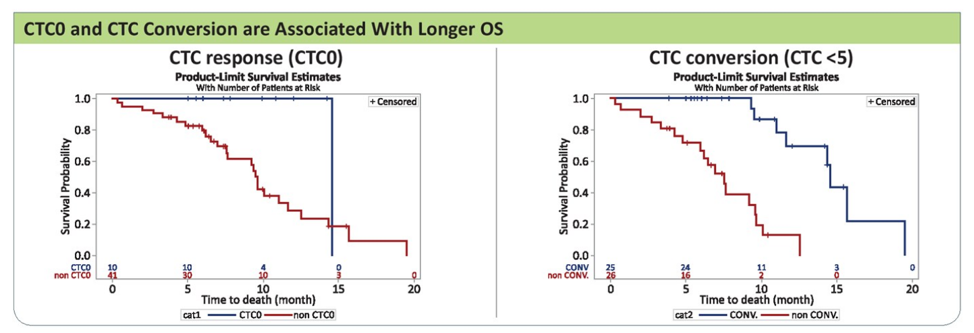San Francisco, California (UroToday.com) Approximately 50% of patients with metastatic castration-resistant prostate cancer (mCRPC) cannot be assessed for a response using RECIST 1.1 criteria and there is a need to develop a dynamic endpoint that provides an early indication of clinical benefit. Circulating tumor cells (CTCs) are easily accessible, reflect tumor biology, and could be a marker of anti-tumor activity beyond PSA and conventional imaging. CTC0 and CTC conversion to <5 CTCs/7.5 mL blood may occur very early on treatment and were highly correlated with OS across 5 large phase III trials of mCRPC therapies in a recent landmark paper by Heller et al.1 Niraparib, a highly potent and selective poly (ADP-ribose) polymerase (PARP) inhibitor received breakthrough designation by US FDA for treatment of patients with BRCA1,2 mutant mCRPC who progressed on taxane and androgen receptor-targeted therapy. CTC detection associates with poor outcomes, with declining counts consistent with improved survival. At today’s prostate cancer session at GU ASCO 2020, Matthew Smith presented results of their CTC correlative data assessing CTC0 as an endpoint in mCRPC.
The GALAHAD study assessed niraparib (300 mg daily) in patients with mCRPC plus DRD. Patients with non-measurable soft tissue disease by RECIST 1.1 were required to have a baseline CTC count ≥1 cell/7.5 mL blood. CTC response was defined as CTC conversion to <5 for patients with baseline CTC≥5 and CTC drop to 0 post-baseline for patients with ≥1 baseline CTC.
There were 204 patients included in this study. For the primary efficacy population of patients with BRCA1/2 mutations, the objective response rate (ORR) by RECIST 1.1 criteria was 41.4%. CTC response rates for this population were as high as ORR regardless of measurability:
CTC0 and CTC conversion were early indicators of response and are associated with longer time on therapy in patients with measurable and non-measurable disease. Furthermore, CTC0 and CTC conversion are associated with longer OS:
Additionally, CTC0 was associated with improved rPFS in the overall population, and CTC0 and CTC conversion were also associated with PSA reduction among these BRCA patients.
Dr. Smith concluded with several take home messages:
- The GALAHAD trial was the first to prospectively assess CTC0 and CTC conversions as measures of response in mCRPC
- With niraparib treatment, CTC0 and CTC conversion was 49%, 95% CI (34.8, 63.4%)
- The CTC conversion rate in non-measurable disease was similar to patients with measurable disease highlighting the benefit is consistent in all mCRPC patients with BRCA mutation
- CTC0 and CTC conversion should be considered as a valid endpoint (regardless of measurable or non-measurable disease) in single-arm as well as randomized trials in mCRPC
Clinical trial information: NCT02854436
Presented by: Matthew R. Smith, MD, Ph.D., Professor of Medicine, Harvard Medical School, Assistant in Medicine, Hematology/Oncology, Massachusetts General Hospital, Boston, Massachusetts, USA.
Written by: Zachary Klaassen, MD, MSc – Assistant Professor of Urology, Georgia Cancer Center, Augusta University/Medical College of Georgia Twitter: @zklaassen_md at the 2020 Genitourinary Cancers Symposium, ASCO GU #GU20, February 13-15, 2020, San Francisco, California
References:


